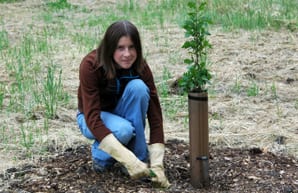How do students learn the skills necessary to work with those who are different from them? How do they come to understand the global ramifications of local actions? How does higher education effectively train this generation for the global workforce? 
The answers to these questions can be found through international volunteer service, which is increasingly seen at a broad range of institutions of higher education in a multitude of forms.
“Most colleges and universities are engaging in something called internationalization of curricula, and the idea is that many universities realize their place in globalization and that it’s not just partnering with other universities and colleges around the world, or accepting international students to come to our campuses, but really embracing the idea that we are creating global citizens through our educational process,” says Amanda Moore McBride, PhD, associate professor and research director at the Center for Social Development (CSD) at the Brown School at Washington University in St. Louis.
“While it is not new to higher education, international service pedagogy is at the threshold of a new era,” she says. “We have both the opportunity and responsibility in higher education to support and critically assess the international service performed by our students.”
McBride also directs the Gephardt Institute for Public Service at WUSTL.
International service in higher education takes many different forms, from internships and alternative spring breaks to study-abroad programs and credit-bearing international service-learning programs.
“I think students benefit from doing civic engagement work, whether it’s domestic or international, because primarily what these experiences do is take students out of their comfort zone,” says Eric Mlyn, PhD, executive director of DukeEngage, an international service program at Duke University.
“Whether they’re working in Durham, North Carolina, or in Haiti, students confront people who are different than themselves, they confront obstacles that they need to somehow deal with and overcome,” Mlyn says. “I think we are creating young leaders, we’re creating global citizens, and we’re creating a generation that will be deeply committed to civic engagement work, whether they are investment bankers or working for Teach for America.”
International service is not discipline specific; examples span technical and non-technical areas and programs and can be found everywhere from the humanities to schools of engineering.
“These diverse forms of service have many objectives and use different approaches to prepare and support students,” Mlyn says.
“Regardless of the form, we bear direct responsibility as our students embark on these service activities,” he says. “Our responsibilities are, of course, not only to the education of our students, but also to the communities that they serve. Our preparation and support for their service should be evidence-based.”
Measuring the impact
The Brookings Initiative, together with partners at Washington University’s Center for Social Development (CSD), is assessing the field of international service, including researching its impact on volunteers and communities.
“There’s been a dearth, historically, of impact research on international service, so we’re adding to that body of literature and, at the same time, looking at the significance of global service in our nation’s public diplomacy,” says David Caprara, director of the International Volunteering and Service Initiative at the Brookings Institution.
“We are increasingly seeing a need for greater assessment of both the impacts and outcomes not only of Peace Corps, but of this broadened array of global actors in development that include global service: NGOs, universities and corporations.”
A major component of the Brookings Initiative is the Building Bridges Coalition, a group of more than 300 NGOs, corporations and universities that work together to advance the field of international service.
“One of the things that we hope is an outcome of the research that we do, is really moving toward standards in the field,” McBride says.
“If you were a host community and you would like international volunteers, for any number of reasons, you’ll be able to look at different colleges and universities and see that they embrace a range of values or structures that have your best interest as the host community — that has your best interest in mind. And it’s not just looking for service to develop the students, but instead, to serve as a partner.”
On campus
McBride and Mlyn manage and fund international service programs at their respective institutions.
“The last five to 10 years have seen breakthroughs in the overall knowledge base and interest in international service,” says McBride.
“Yet we struggle to move beyond the confines of our individual schools, disciplines and program type. In general, we have ‘siloed’ the forms of service, not fully embracing the role we can or should play in promotion of co-curricular international opportunities.”
Mlyn says that increased collaboration in both programming and evaluation are clearly the next steps for academia.
The CSD and the Gephardt Institute for Public Service at WUSTL and DukeEngage recently convened a symposium on international service and higher education in partnership with the Brookings Institution, the Building Bridges Coalition and ServiceWorld.
A major outcome from the symposium was the launch of a consortium of 40 universities and colleges to grow the international service field, both in terms of pooling research and best practices in this field.